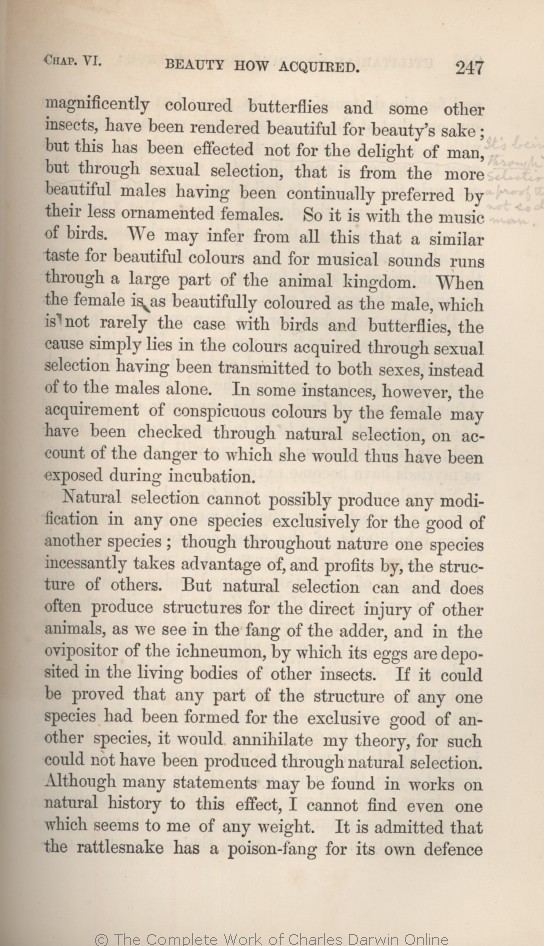host of magnificently coloured
butterflies | butterflies 1866 1869 | | butterflies, 1872 |
| and some other insects, 1866 1869 |
| OMIT 1872 |
| beautys 1869 | | beauty's 1866 1872 |
| not for the delight of man, but 1866 1869 |
| OMIT 1872 |
| is from 1866 1869 | | is, by 1872 |
| their less ornamented females. 1866 1869 |
| the females, and not for the delight of man. 1872 |
| similar 1866 1869 | | nearly similar 1872 |
| simply 1866 1869 | | apparently 1872 |
| transmitted to 1869 1872 | | inherited by 1866 |
| 3 blocks not present in 1859 1860 1861 1866 1869; present in 1872 | | How the sense of beauty in its simplest form— that is, the reception of a peculiar kind of pleasure from certain colours, forms, and sounds— was first developed in the mind of man and of the lower animals, is a very obscure subject.
The same sort of difficulty is presented, if we enquire how it is that certain flavours and odours give pleasure, and others displeasure.
Habit in all these cases appears to have come to a certain extent into play; but there must be some fundamental cause in the constitution of the nervous system in each species.
|
| 1 blocks not present in 1859 1860 1861 1869 1872; present in 1866 | | We can sometimes plainly see the proximate cause of the transmission of ornaments to the males alone; for a pea-hen with the long tail of the male bird would be badly fitted to sit on her eggs, and a coal-black female capercailzie would be far more conspicuous on her nest and more exposed to danger than in her present modest attire.
|
|
|
Natural selection cannot possibly produce any modification in
any one | any one 1859 1860 1861 1866 1869 | | a 1872 |
| structure 1859 1860 1861 1866 1869 | | structures 1872 |
| others. 1869 1872 | | another. 1859 1860 1861 1866 |
| animals, 1869 1872 | | species, 1859 1860 1861 1866 |
| deposited 1861 1866 1869 1872 | | depo- sited 1859 | | depo- sisted 1860 |
| defence 1859 1860 1861 1866 1869 | | defence, 1872 |
|









